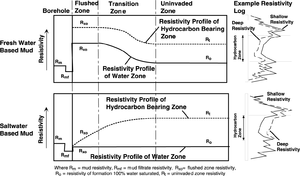True resistivity determination
| Exploring for Oil and Gas Traps | |

| |
| Series | Treatise in Petroleum Geology |
|---|---|
| Part | Predicting the occurrence of oil and gas traps |
| Chapter | Predicting reservoir system quality and performance |
| Author | Dan J. Hartmann, Edward A. Beaumont |
| Link | Web page |
| Store | AAPG Store |
The true resistivity (Rt) of a formation is its resistivity when not contaminated by drilling fluids. It may contain formation water only (Sw = 100%) or formation water and hydrocarbons (Sw t is fundamental when analyzing well logs for the presence of hydrocarbons. For a discussion of resistivity concepts see Asquith, 1982.
How invasion affects rt measurement
During the drilling process, filtrate water from the drilling fluid invades the formation. Its resistivity (Rmf) is either greater than, less than, or equal to Rt and can distort deep resistivities. Distortions to resistivities due to invasion must be corrected to get a valid Rt value. The diagram below shows resistivity profiles of formations with fresh and saltwater mud filtrate invasion.
Obtaining a valid rt value
Use the table below to obtain an uninvaded zone resistivity (Rt).
| Step | Action | |||
|---|---|---|---|---|
| 1 | Read the resistivity of the log with deepest investigation (ILD, LLD, etc.). | |||
| 2 | Use the table below to determine how to make corrections.
| |||
| If… | Then… | |||
| Bed is | Correct for this bed using appropriate service company chart | |||
| Shallow, medium, and deep investigating tools measure, different resistivities (i.e., log has step profile) | Correct for invasion using appropriate service company tornado chart |
See also
- Determining water saturation
- Calculating Sw from the Archie equation
- Calculating Rw from SP logs
- Constructing a Pickett plot
